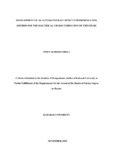| dc.description.abstract | There has been drastic growth in the microelectronics industry in the recent past.These industries utilize different materials, the main being thin-film semiconductors. The performance of these materials is influenced bytheir structural, electrical, and optical properties among others, depending on theirapplications. Therefore,theneed to electrically characterizesemiconductorsprecisely, quickly, and convenientlycannot be overstated. Some of the desirable features of measurements include usability, accuracy, resolution, repeatability, and consistency which cannot be assured with manually operated systems. This study strived to design,build, interface and assemblean automated computer-aided four-point probe test equipmentthatcan characterizematerials to determine their electrical properties such as resistivity, charge carrier type, charge density, and carrier mobility. A four-point probe head, two magnets, NIKeithleymodel 6220 Precision current source, model7001 switch,model 2182A Nanovoltmeter, and model 7065 Hall Effect card instruments wereinterfaced with the NI LabVIEW program running in a computer through a GPIB hub to a PC USB for its full control. The four-probe head was utilizedto probe the samples with a square symmetry that was adopted for the measurement of the semiconductor properties. Reliability tests were then used tomeasurea semiconductor sample's electrical properties comparedwith the expected results. This work forms a basis for automating similar systems that were inherently designed to be operated manually. The electrical properties of a P-type Germanium thin film sample 1.00cm wide, 2.00cm long, and 1.00 mmthick wereobtained to validate theHall Effect measurement system.When the sample was placed perpendicularly across a magnetic field strength of 258.125mT at a room temperature of 292.45K, a resistance of 1.97711 Ω, a conductivity of 252.8946 Sm-1, resistivity of 3.9542×10-3 Ωm, a Hall Co-efficient of 7.6595×10-3 m3/C a carrier concentration of 8.1487×1022m-3, a Hall angle of 0.4637rad, carrier mobility of 1.9370 m2(vs)-1and a doping type of P-type was reported.These results had a deviation of 0.3% in comparison to the data collected and analyzed manually. The measurements concluded that a system offering a fast, simple, effective and reliable method for thin film Hall Effect electrical characterization can be developed and built. | en_US |

